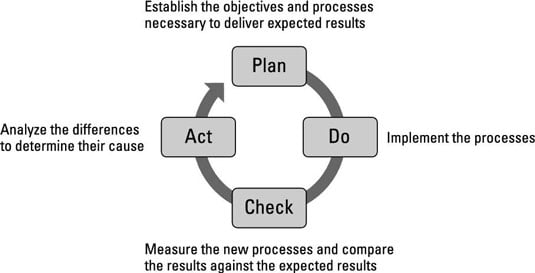Modern quality management is something you should have a handle on for the PMP Certification Exam. It focuses on customer satisfaction, which is generally defined as conformance to requirements and fitness for use. In other words, the product, process, and project meet the requirements, and the end result is used and useful.
Certainly, when talking about product satisfaction, the focus is on the customer; however, project satisfaction needs to take into consideration the project team, the sponsor, vendors, regulatory entities, and other project-specific stakeholders. Therefore, “project quality management,” refers to a focus on stakeholder satisfaction. It’s important that all stakeholders are satisfied, not just the customer. In this sense, quality management is very integrated with collecting requirements and planning stakeholder management.
Another fundamental tenet is that quality should be planned, designed, and built in, rather than inspected in. A project is generally less expensive if you go into it preventing mistakes from happening rather than correcting those mistakes later on in the project’s lifecycle.
Part of quality management is continuous improvement. This goes for product and project quality. The underlying basis for quality improvement is the plan-do-check-act cycle that Walter Shewhart developed and J. Edwards Deming refined and publicized in the 1950s.

Much of the capability to significantly improve a product or process is dependent upon an investment in quality. This type of investment is usually done outside the project. Typically, management is responsible for the investment and providing the resources and organizational support for quality management. Examples include bringing proprietary methods (such as Capability Maturity Model Integration; CMMI) into the organization, or investing more in appraisal and analysis versus defect repair.
One of the aspects of quality you need to be familiar with is the distinction between quality and grade.
Quality. The degree to which a set of inherent characteristics fulfills requirements.
Grade. A category or rank used to distinguish items that have the same functional use (say, a hammer) but do not share the same requirements for quality (say, different hammers may need to withstand different amounts of force).
For an example of a childcare center, you can compare quality and grade by the selection process used to choose a secure entrance for the facility. One vendor, Secure Source, proposes using a security system with cameras, retinal scans, infrared beams at the windows, a double-door entry system, and panic buttons that are directly wired to Secure Source.
Another vendor, Breach Proof, proposes using a double door with a badge swipe machine for entry. This would be bolstered with a computer application called Guardian that records entry and exit times by person as well as authorized drop-off and pick-up persons.
You do some research on both companies and find the following reviews for Secure Source:
“We used Secure Source, and I got caught in between the double doors with my daughter. They couldn’t get us out for 2 hours.”
“The retinal scanners keep going off line, and we have to shut down and reboot the system to get them to reset.”
“When we called the hotline to test the responsiveness, we were put on hold!”
Then you do some research on Breach Proof and see the following reviews:
“When I called, they picked up right away. The people were very helpful, and their response time was excellent.”
“The Guardian system is wonderful! It is so easy to use. It not only keeps the facility secure, it helps me plan my staffing!”
These examples demonstrate that while Secure Source is high grade (it has lots of features and functions), it is low quality (doesn’t meet the criteria of “fit for use”). On the other hand, the Breach Proof proposal is lower grade, but it is fit for use. In other words, it is higher quality because it meets the needs, doesn’t break down, and is used — and useful.
Another distinction you need to know is the difference between accuracy and precision.
Accuracy. Within the quality management system, accuracy is an assessment of correctness.
Precision. Within the quality management system, precision is an assessment of exactness.
Here’s a scenario for the childcare center example. The foreman is working with two new apprentices. He needs to frame some windows. He tells the apprentices he needs 24 boards that are four feet long, and each apprentice should cut 12 boards.
The foreman comes back and checks the results. One apprentice, Ryan, has his boards lined up; even without measuring, the foreman can tell that they are different lengths. He tells Ryan that he needs to work on his precision so that all the boards are the same length.
Next, the foreman looks at Seth’s work. At first, he is very pleased. All the boards are lined up against the wall, and they are all the same length. He thinks this is very good. However, after the foreman measures the boards, he finds they are all 46.75″ — not the 48″ he asked for. So, although the measurements are precise, they’re not accurate.
If you remember the preceding two scenarios, you’ll do fine answering questions about grade, quality, accuracy, and precision on the exam.
You might come across a few other concepts on the exam:
Total Quality Management (TQM): The practice of TQM focuses on organizations always looking for ways to improve the quality of their products and processes.
Continuous Quality Improvement (CQI): Like TQM, this practice also looks to improve the quality of products and processes, but it focuses on continuous incremental improvements. You may also hear this referred to as Kaizen, the Japanese word for improvement.

